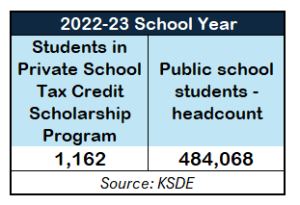School choice advocates just celebrated a milestone in the number students in private schools pursuant to choice initiatives. According to EdChoice, there is now in excess of one million students who have accessed private school choice options in 33 states, D.C. and Puerto Rico. Borrowing a punch line from an old joke, that’s a good start. That number will undoubtedly increase as Louisiana’s GATOR and Alabama’s CHOOSE ESA programs (don’t you love those legislative acronyms!) will soon join the other eleven states that have some form of universal ESAs.
Surprise, surprise! Kansas is not one of those lucky 13 states. However, Kansas is one of the 33 states with a private school choice option. Although a gallant effort, the problem with the Kansas program is that it is so limited in scope the number of students taking advantage of an alternative to attending a public school not of their choice, is barely a blip on the K-12 education radar screen. The adjoining table is evidence of that.
According to the latest report from KSDE, 1,162 students participated in the tax credit scholarship program in 2022-23 school year. Compare that number to the statewide headcount enrollment for public schools – 484,068. To put that imbalance in perspective, using KSDE attendance data, the average number of students absent daily in Wichita USD 259 was 4,160 that same year. That is nearly four times the total number of students participating in the tax credit scholarship program.
scholarship program in 2022-23 school year. Compare that number to the statewide headcount enrollment for public schools – 484,068. To put that imbalance in perspective, using KSDE attendance data, the average number of students absent daily in Wichita USD 259 was 4,160 that same year. That is nearly four times the total number of students participating in the tax credit scholarship program.
At the rate more states are climbing aboard the ESA train, why doesn’t Kansas join the party? That’s the only question that remains: Why?
Why would the state be so willing to subsidize rich, successful major league franchises – the Chiefs and the Royals – but not willing to make the same financial commitment to individual students and families regarding their education? Could they be suffering from FEE (fear of education establishment) syndrome? Imagine the long-term economic impact of investing a billion dollars toward school choice.
A joint letter to Governor Kelly from KPI and the Show-Me Institute in Missouri asserts that “(s)ubsidized projects do not work for taxpayers largely because ongoing economic activity is merely shifted. Citizens have no new money to spend; they are just spending existing dollars elsewhere.” It would not be the case if that kind of commitment was made to educate Kansas students. Public money would be going toward new activity, not existing government schools. The potential long-term economic impact is undoubtedly significant.
The path forward for ESAs in Kansas has been cleared by the U.S. Supreme Court since the Espinoza v. Montana case, now four years old. In that historic case the so-called Blaine Amendments in roughly 40 states’ constitutions– including the Kansas constitution – do not pass constitutional muster because they are a First Amendment violation of one’s freedom of religious exercise.
Pursuant to Espinoza, the Kansas version of the Blaine Amendment is now unconstitutional. The largest, bigoted attempt to stop school choice programs around the country is a dead letter. There is no legal means to stop Kansas from adopting a universal ESA, as several states have done in the past few years.
If the Chiefs and Royals remain ‘stuck’ on the Missouri side of the imaginary line, they’ll be just fine. So will the fans of either team. Can the same be said for students stuck in underperforming schools, ones in which they have no escape? They certainly don’t have the political wherewithal to hire dozens of lobbyists to change their fate.
What does it say about the state’s political leadership who are willing to promote corporate welfare while forsaking educational opportunities of state’s students, many of which are among the most vulnerable?
The million-student milestone for private school choice is certainly to be lauded, as is the hard work school choice advocates have put into the effort. However, there is much more to be done because the truth is, all students deserve the opportunity to find the education path that is best fit.




